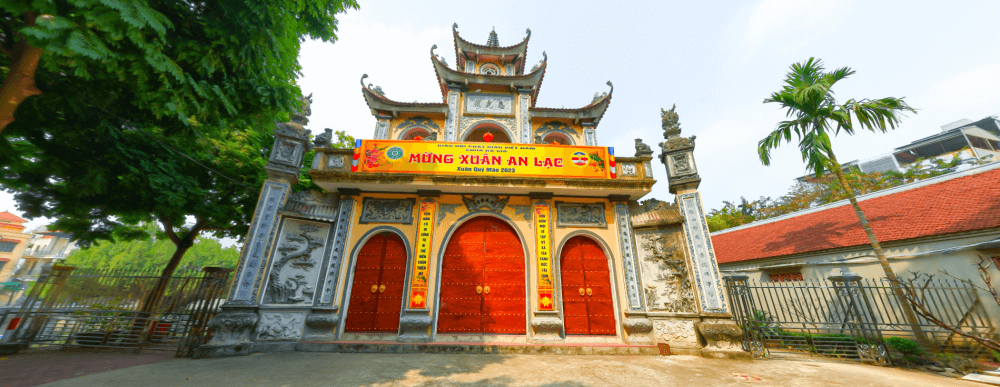

Introduce
Ba Gia Pagoda is in the North West of West Lake, which is about 9km from the city center. The pagoda’s name is called after the name of the hamlet which it is located in. Currently, it is in Phu Thuong ward, Tay Ho district, Hanoi.
Phu Thuong is a land which has thousands of years of background, along with antique village names such as: Ke Xu as Phu Xa village, Ke Ga is Phu Gia village, Ke Bac is Thuong Thuy village. These three villages consolidated into one commune with the name of Phu Thuong. Back in the Le dynasty, Phu Gia commune was under Phu Gia canton, Hoai Duc district, Ha Dong province. After 1945, the commune was known as a “Hanoi special geo-location”. In 1955, the commune was named Phu Thuong, located in V district, which is the suburb of Hanoi. By 1961, it was under Tu Liem district and in December 1995, Phu Thuong commune was officially a part of Tay Ho district, Hanoi.
Long ago, Phu Gia village was called Ba Gia Huong, later changed into An Duong ward. In the Tran dynasty, the king ordered the people of An Duong ward to repair Dong Bo Dau wharf and bank Dai La citadel to prevent the invasion of the Nguyen dynasty so he changed the name into Phu Gia village.
Ba Gia Pagoda is on the right side of Red river, which is 1 km downstream from Thang Long Bridge. This pagoda is an early Buddhist architecture. Even back in Le dynasty, the pagoda had already famous for its size and scale, which led into a quote:
Largest is Ba Da pagoda (Hoan Kiem)
Second large is Ba Dinh pagoda (Thuy Khue)
Third large is Ba Gia pagoda (Phu Thuong)
About the name of the pagoda, “Ba Gia” (which means old lady in Vietnamese), there was a story about it: when An Duong pagoda was ruined, there were two old ladies spent their own money to build and restore the pagoda, mold more Buddha statue, rebuild the belfry, recast the bell. Until now, the pagoda is still preserving the bell.
After this restoration, the pagoda is called Ba Gia pagoda to show the gratitude of the villagers toward the two old ladies and the statues of them were also placed in the pagoda.
Some researchers explained that “Ba Gia” is a Chinese—transcribed Vietnamese word which comes from a Cham word “DaDaLi”, which means a land of flourishing, so Ba Gia is also translated into Phu Gia (which means a land with lots of rich families).
The pagoda is built on a large area with the shape of a turtle, located in the North of the village. Its face towards the South, to the left is the orchard and the lake and behind the pagoda is Red River. The pagoda has a great geolocation and natural landscape. It is a fascinating tourist attraction in the tour of relics route: Kim Lien pagoda –Tay Ho palace – Hai Ve historical monument – Ba Gia pagoda – Ve temple – Chem temple.
The document on the stone tablet “Ba Gia tu bi ky” which was placed in the pagoda said that the pagoda had a great restoration in 1636. The paragraph on the bell which was written in 1695 showed that the pagoda was built before 1636. Until now, the pagoda has gone through many repairs. The pagoda has the layout of the letter “cong” in Chinese. The pagoda included its three-arched-entrance gate, the front house, altar of ancestors and many more structures. All of these structures were well placed in an open space area, with antique houses under the trees.
Pagoda’s three-arched-entrance gate is built as a belfry, the top is structured as two layers with 8 sub-roofs, covered with tile, doors are open in all directions with small dragon statues above it. The upper floor is where the bell is hung.
After passing by the three-arched-entrance gate, you will reach the garden and the pagoda yard. From there you can see the main pagoda.
The front house is divided into 7 parts, covered with tiles, in the front are 2 pillars with the top shaped as 4 phoenixes, facing toward 4 directions. Inside, there are 6 rows of wooden pillars, made with style of “thuong thu – ha thach” and placed stone that is 41 cm above the ground. The floor is covered by 20cm x 20cm bricks. There are also art works of “conifer, daisy, bamboo, apricot blossom”, that are often seen in Vietnamese antique architectures. On top of them are images of flowers and clouds.
The three-part main building is connected to the front house, built along the back with the style of retaining wall and covered by tile on the roof. The frame of the house is made of ironwood, which is connected to the middle part of the front house. The plan consists of four rows of wooden posts supporting the roof. There are four sets of roof trusses with the layout called "chong ruong". Tiles which are used on the floor are square.
Statues inside the three-jewels of the pagoda are well arranged, strictly following the principle of Buddhist morality.
At present, the pagoda still preserves a variety of rich and diverse relics including 58 round statues, including 46 Buddha statues, 1 ancestor statue, mother statues and other 11 statues. The statues are made with elaborate workmanship, lacquer, gorgeous yellow as the artistic style of the 17-18-19 centuries.
In addition, the pagoda also keeps a number of artifacts: Two bells, including a bell from 1695. The bell is 146 cm in height and 86 cm in diameter, both four sides of the bell are engraved with Chinese characters. The bell also has six knobs, which are decorated with circular dots.
The smaller bell was made in 1928 with the diameter of 30 cm and the height of 60 cm by Buddhist names Nguyen Toan.
About the wooden furniture, there are 10 pairs of wood panels (on which are inscribed parallel sentences). The parallel sentences were written to praise the beauty of the pagoda and the Buddha.
Eight stone tablets are made of smooth white stone. The largest stone tablets are carved with the line "Ba Gia tu bi ky" which is 90 cm high, 51 cm wide and 15cm thick, made in 1636. The upper part of the tablet is decorated with dragons flanking the sun and on the side are stone ribbons of chrysanthemum cord.
With all of the above mentioned tangible and intangible cultural values mentioned above, the Ba Gia Pagoda was recognized by the Ministry of Culture, Sports and Tourism as the cultural and historical monument of the Ministry of Culture, Sports and Tourism. Decision No. 2996-QD / VH dated November 5, 1996.
Artifacts
Map
Nearby Places
No. 43C, alley 497, quarter 2, group 15, Lac Long Quan Street, Nhat Tan Ward
1.36Km
No.6, Lane 319, An Duong Vuong Street, Phu Thuong ward
1.48Km
Lane 242, Lac Long Quan Street, Buoi Ward, Tay Ho District, Hanoi.
No. 20, Lane 472, Cluster 3, Lac Long Quan Road, Nhat Tan Ward, Tay Ho District, Hanoi.
No. 35, Lane 416, Lac Long Quan Road, Nhat Tan Ward, Tay Ho District, Hanoi.
1.56Km
No. 07, Lane 30, Tay Ho Road, Quang An Ward, Tay Ho District, Hanoi.
2.27Km
Residential Area No. 5 (No. 3, Lane 200, Au Co Road), Tu Lien Ward, Tay Ho District, Hanoi.
2.84Km
Residential Area No. 5 (No. 3, Lane 200, Au Co Road), Tu Lien Ward, Tay Ho District.
2.71Km